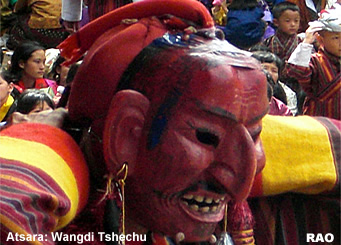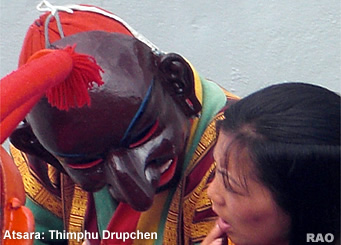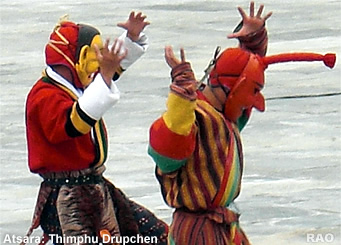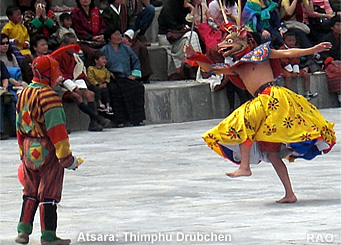 |
Bhutan Festivals |
|
 |
Bhutan Festivals |
|
|
 |
| TSHECHU (RELIGIOUS FESTIVAL) |
| The
Role of the Atsara |
 |
Sandwiched
between two large tourists at the Trashichhodzong courtyard in Thimphu,
the familiar atsara face with a permanent grin brandishes a wooden phallus,
rests it on the head of a young girl and says: "May you be blessed with
nine boys."
"Nine
is too much," reacts an elderly observer. "Then let it be 11 so that you
can have a football team." The crowd bursts into laughter as the man in
the mask leaves to help a hunchback find a place to sit.
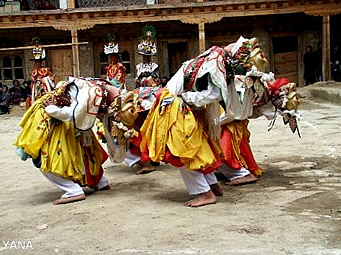 |
| Tshechu Mask Dance |
| The atsaras are the clown figures who entertain the crowds at tshechus. But their role
and significance transcends entertainment. "We are an indispensable part
of the tshechu," says a senior atsara, or atsara gom (senior), played by
a student of the Royal Academy for
Performing Arts (RAPA). "There is a world of meaning to the atsara
figure and we have a big responsibility."
According
to Phub Gyeltshen, they should have mastered all the mask dances. "As the
atsaras should correct the dancers if they make mistakes he should know
the sequence of the dances and all other rituals in between the mask dances
or associated with the dances," he explained. |
|
The
atsaras have multiple roles, according to Chencho of Chang Olakha in Thimphu.
The 65-year old, who has played as an atsara for 12 years, said the atsaras
also explain the meaning of mask dances to spectators, entertain them when
dancers are in the changing room, and help control the crowd.
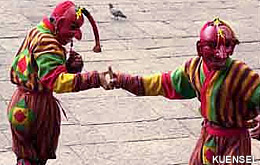 |
| Atsaras |
| From
the eight atsaras at the Thimphu tshechu,
four are selected from the geogs and four from RAPA. Although atsaras from
the villages are not professional dancers they help the dancers by tying
their mask threads, adjust falling dance robes, and even find missing children. |
|
Atsaras
also perform the Atsara Ngon Cham on the last day of the Tshechu.
According to Phub Gyeltshen, the dance is an interpretation of the resurrection
of legendary hunter Sharop Gyem Dorji. "Through the dance it teaches people
that even the most sinful is enlightened if he follows the path of Buddha's
teachings," Phub Gyeltshen said.
The
term atsara, according to Bhutanese scholars, is derived from the Sanskrit
word Acharya (holy teacher) called dubthop in Dzongkha.
top
| The
Legend of the Atsara |
 |
Legends
say that about 84 dubthops (Mahasiddhas), who had extinguished all
defilements and afflictions, roamed the universe to subdue evil thoughts
by mocking at worldly things.
Colourfully
dressed, eccentric in behaviour, and even vulgar and abusive in language,
the dubthops used their wit and tricks together with their powers to uproot
evil from the minds of mortals.
"The
atsaras today represent these learned and saintly beings," according to
a scholar, Dasho Lam Sanga. "The dubthops cultivated detachment from mortal
feelings like embarrassment, hesitation, and reservation, as such they
appear in these forms and are always vulgar."
Dasho
Lam Sanga said that atsaras also symbolised spiritual protection. The balloon
and the wooden phallus, which the atsara holds are symbols. The balloon
represents the swine bladder, which the dubthops used to collect diseases
sown by demons. The wooden phallus symbolises the genuine accomplishment
of wisdom by the dubthops, and the tang-ti (rattle), represents khandoms
(consort) of the dubthops. Atsaras from the villages have their
own interpretation. According to Chencho, the four masks they wear symbolise
the four protective deities of the Thimphu valley. The
red mask is the Dorji da-tse, blue
is the Yeshey Gonpo and other
two are the Geynin Bjakpa Mila of Dechenphug and the Dungla Tsen.
Atsaras
feel spiritually lifted and happy performing their roles during the three-day
Tshechu although sometimes they have to face uncomfortable situations in
response to their lewd and vulgar comments. "It's a part of the tradition,
but people don't understand," said Chencho.
"Atsaras
do not respect time and place," a young student said. "It is embarrassing
when you are with your parents and atsaras come with their vulgar jokes."
Today
atsaras are also criticised for asking for money during the tshechus. Although
atsaras claim that this was a part of the tradition, a new rule now allows
the atsaras to collect offerings only during the last day of the tshechu.
On an average an atsara collects about Nu.10,000. Chencho collected Nu.14,000
last year.
"They
are a wonderful part of the Tshechu," a tourist, Marsha Davis, said. For
Lil Laidlaw from Montana, United States, who boasts of an atsara mask back
in her room in Montana, atsaras keep the tshechu alive.
top
| The
Atsaras at the Thimphu Tshechu |
 |
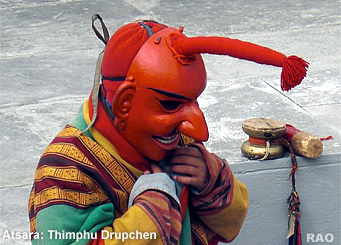 |
| Tshechu Mask Dance |
|
They
can be witty and wry, lewd and salacious, annoying and bothersome, but
without them a tshechu would be tame.
The
Atsara, in his the wooden mask with a crooked red hawkish nose and a permanent
grin, and commonly seen as the jester of the tshechu, is more than the
mask depicts.
Atsara
is derived from the Sanskrit word Acharya (holy teacher) or dubthop
in Dzongkha.
|
|
According to religious history, about 84 dubthops (Mahasiddhas),
who had extinguished all defilements and afflictions, roamed the universe
to subdue evil thoughts by mocking worldly things.
Weirdly
dressed, whimsical, vulgar and abusive in language, the dubthops used their
wit, foolery, and drollery, together with their powers to uproot evil from
the minds of mortals.
Atsaras
today represent these learned and saintly beings. Their apparent vulgarity
arises out of their detachment from human feelings like embarrassment,
hesitation, and reservation.
At
2007's Thimphu tshechu 29-year-old Tsagay, a student of the Royal Academy
of Performing Arts (RAPA), is the Atsara gom (head Atsara).
Tsagay,
a father of two children, calls himself an artiste. "It is no joke being
an Atsara at the tshechu," says Tsagay. "Without mastering all the mask
dances, you cannot become the head Atsara. It is an art."
According
to Tsagay, Atsaras are spiritual figures at the tshechu, who carry the
blessings of mask dances, and, through the auspiciousness of the day, can
heal or cure.
Dorji
Wangmo, 63, never misses receiving wang (blessing) from the Atsara.
According to the farmer from Kabisa, the lewd remarks and outrageous behaviour
of Atsaras when they come to bless people is a test in itself. "It is way
to test if people are ready to embrace religion in all forms," she said.
Dawa
Nob is another Atsara at the tshechu selected from Thimphu's Toeb gewog.
"We have a big responsibility," he said, waving a wooden phallus. "We are
the guides here for the mask dancers and also for spectators. We explain
the meaning of the dances and correct any mistakes in the dance steps."
This
year, on their own initiative, the Atsaras decided to promote the use of
contraceptives. "If you use condoms, you will live long," an Atsara explained
in English to a group of tourists. "Yes," the tourists agreed.
"It's
a good opportunity to educate people because they are not embarrassed listening
to an Atsara," he said.
Most
spectators see Atsaras as entertainers in an otherwise formal festival.
"The first thing that comes to mind when we talk of a tshechu is an Atsara,"
said Choki Lhamo, a student. "I don't mind their dirty jokes as long as
they keep them within limits," she said.
"I
love them," said Mark Beltzman a tourist from the US, "They are a great
transition between the dancers. We should have more of them."
But
Atsaras also face awkward situations when women react angrily to their
lewd jokes. "Sometimes they do get excited and grab us," said a woman spectator.
| This
article was contributed by Ugyen Penjore, KUENSEL, Bhutan's National Newspaper
2007 |
 |
| Information on Bhutan |
 |
|





